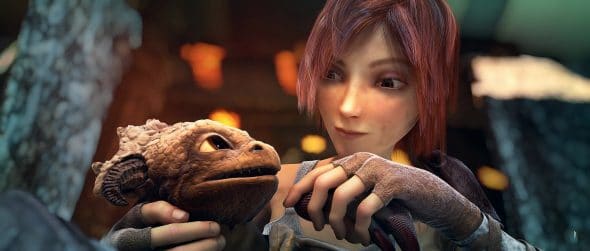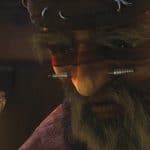Sintel, the fourth open movie from the Blender Foundation, is out. Building on the success of its previous open movie projects, this release has upped the ante by depicting a tragic showdown, complete with jaw-dropping effects and life-like animation.
Sintel is an independently produced short film, initiated by the Blender Foundation. In the tradition of code-naming each of its open movie projects after fruits, this fourth project from the Blender Institute is called Project Durian (a fruit native to Indonesia, Malaysia and other south east Asian countries).
The main idea behind these projects has been to facilitate Blender development, and give an impetus to the open movie programme. The Blender Foundation started the open movie project back in 2005, with the release of the highly acclaimed Elephants Dream. Ever since this first success, the Blender Foundation has continued releasing open projects under various categories, featuring and developing different aspects of the open 3D modelling software, Blender.
The Blender Foundation’s varied open projects include three open movies, and an open game. Every project is unique, and focuses on certain features for Blender development. The third open movie project converged towards the development of the next stable release, 2.5/2.6. Likewise, the full Sintel movie was developed on the Blender development branch.
The beginning
The project was initiated on May 5, 2009, under the guidance of Colin Levy (director), David Revoy (art director) and Ton Roosendaal, steering the production of the movie. The project was inspired by the works of a famous Dutch comic writer, Martin Lodewijk. Like with other projects, artists were welcomed to showcase their talents by creating a spell-binding movie. Far exceeding the Blender Foundation’s hopes, a whopping 150 artists showed interest in working on the next open movie, though the list was pared down to five to begin with, later being increased to a team of 18 whose work included the storyboard, production, consultancy and development. The initial five artists were Angela Guenette (for modelling, rigging, animation), Ben Dansie (a 3D generalist), Nathan Vegdahl (rigging, animation), Lee Salvemini (animation) and Soenke Maeter (shading, light, compositing).
The Blender Foundation was determined to avoid the shortcomings of its earlier open movie project, Peach, which had a weak story line. To present a dramatic short film, the Foundation approached Esther Wouda for the story line. With this aspect entirely under her command, she worked closely with the rest of the team. The film got financial support from the Netherlands Film Fund, leading to further enhancement and an expansion of the project. Several more sponsors coming on board led to the inclusion of high-end goals like a 4k render of the film; the duration of the movie was also increased considerably from ~8min to ~15mins. Subsequently, more artists were hired for the swift development of the project.
The movie
“Sintel is epic, dark and a complete make-over from the previous projects ” was part of the brief given to the team working on the movie. Sintel is, indeed, dark and gloomy when compared to the earlier open movies from Blender. Remember the chivalrous bunny that made us laugh in Big Buck Bunny, and Proog, the tour-guide in Elephants Dream?
However, Sintel will enthral you with its spectacular graphics and life-like animation. The movie begins with soothing sounds, depicting a wilderness of icy peaks where Sintel, the main character, seems to be wandering after she’s been attacked by the “gatekeeper of dragon land”.
In the first half of the movie, Sintel narrates the happenings in her life, and the latter half is when all the drama and action takes place. As the film proceeds, we notice the beautiful Sintel living in a pitiful condition in a remote part of the village. Strong and fearless, she carries a dagger; and her bravery, combined with her motherly instincts, leads her to treat an injured baby dragon.
Soon, both develop a great deal of affection for each other. But one sad day, the baby dragon is snatched away by an adult dragon, and that has a tyrannical effect on Sintel’s mind. Outraged, she marches over tough terrains, brimming with anger at losing her beloved baby dragon, and risking her life to find it. Sintel tries to rescue the baby dragon, and this is where the story has an unexpected and catastrophic end. She destroys what she had protected and nurtured for so long. The movie’s ending is reminiscent of how ‘Kung Fu Panda’ ended — the flower that you see in the end is both a symbol of peace and the regret in Sintel’s mind.
The movie is not a happy, feel-good entertainer; rather, it is shocking and gloomy. But what sets it apart is the unprecedented detailing, storyline and the intense graphics work. Not to forget that the movie will be released in 4k renders as well! The work on the facial expressions is one of the parts that I liked the most. The graphics and detailing is mind-boggling, and is no less than what the top guns in the 3D industry could have delivered. It’s quite amazing how Blender delivers such life-like motion and imagery without the backing of giants like Intel or AMD for rendering and processing. Surely, the Blender Foundation deserves a great round of applause for such astounding work.
The movie is quite good, and the story is much better compared to Blender’s previous project, topped with brilliant voice-overs by Halina Rejin and Tom Hoffman for Sintel and Shaman, respectively. The music in the movie has been produced by Jan Morgenstern, and gels very well with the different moods of the movie, ranging from dark and brooding to soothing and upbeat.
It comes in a 4-DVD set; being a pre-campaign sponsor, I got my DVD delivered right after the project ended. Getting this DVD not only provides you with a physical copy, but also helps fund future projects. The 4-DVD set has lots of goodies, including the model, texture, animation and rendering files used to make the film, as well as various quality renders, and PAL and NTSC versions of the finished film.
Sintel is licensed under Creative Common Attribute 3.0 CC-By, which states that if you own a hard or soft copy of the product, you own the work. Being an open source movie, you can study, edit, redesign the movie, and share it. The aim of the project is not only to produce films, but to fund the Blender Foundation’s future projects, and establish Blender as a prominent 3D modelling software, since one of the strengths of Blender is creating life-like creatures.
The movie lives up to expectations, and further validates Blender as a professional animation creation suite. It’s a great film with enough blood and emotion flowing through it right from the very beginning. A must-watch, it will be a great addition to your media gallery. However, the story-line might not be for everyone, and if you liked Big Buck Bunny, you might not like the sentimental aspect of this one.
What’s next? In an interview with Blenderguru.com, Ton spoke of the next open movie project: Mango. Not many details are out yet, but we did get a glimpse of what could possibly be on the way.
Ratings
- Direction: 4/5
- Screenplay: 4/5
- Story Line: 3.5/5
- Animation and 3D Model: 4.25/5
- Sound: 4.5/5
- Overall: 4/5
















































































